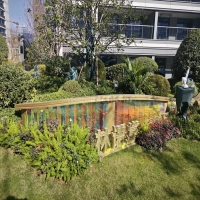Welcome to the website for landscape facilities products and knowledge.
How do manufacturers ensure color consistency in materials like concrete or composite for landscape bar counters?
For architects, designers, and homeowners seeking seamless outdoor living spaces, achieving perfect color consistency across landscape bar counters is paramount. Unlike indoor applications, these exterior surfaces face relentless sun, rain, and temperature fluctuations that can compromise their appearance. Manufacturers of concrete and composite counters employ a multi-faceted, scientific approach to ensure that every slab, whether produced today or next year, matches the specified hue with remarkable precision. This process begins long before production and continues through rigorous post-installation protocols.
The foundation of color consistency lies in meticulous material selection and formulation. For concrete counters, this means sourcing cement, aggregates, and pigments from the same trusted suppliers for an entire project. Even minor variations in the chemical composition of cement or the mineral content of sand can alter the final color. High-quality synthetic iron oxide pigments are preferred for their UV stability and batch-to-batch uniformity. The exact formula—a precise ratio of cement, water, aggregates, pigments, and additives—is documented as a master "recipe." This recipe is sacrosanct; any deviation requires creating a new master sample. Composite materials, often made from resins mixed with mineral fillers or recycled glass, rely similarly on tightly controlled raw materials and pigment dosages to maintain uniformity.
The mixing process is where theory meets practice, and it is a stage demanding robotic precision. In modern facilities, automated computer-controlled systems measure and dispense every component by weight, not volume, for ultimate accuracy. This eliminates human error in measuring. The mixing time and speed are also pre-programmed. Inconsistent mixing can lead to streaking, "lensing" (where pigments concentrate in certain areas), or a mottled appearance. For integrally colored concrete, achieving a homogeneous blend where the pigment perfectly coats every aggregate particle is the goal. Vacuum mixing is often used to remove air bubbles that can rise to the surface and create pale spots once the concrete is cast.
Environmental control within the manufacturing facility is a critical but often overlooked factor. Temperature and humidity significantly impact the curing chemistry of both concrete and resin-based composites. A batch poured on a hot, dry day will cure faster than one on a cool, humid day, which can affect hydration rates in concrete and exothermic reactions in resins, leading to color shifts. Reputable manufacturers produce all materials in climate-controlled environments, maintaining consistent temperature and humidity levels year-round to ensure each batch cures under identical conditions.
Once demolded, the finishing steps must also be standardized. For concrete, the application of chemical sealers or penetrating guards is essential for protection, but these products can also alter the color, typically darkening it. Manufacturers use a consistent type and number of sealer coats on every piece, often applying them to sample chips first to confirm the final color result. The method of finishing—grinding, polishing, or honing—is repeated with the same sequence of diamond grit pads on every slab to achieve a uniform surface texture, which directly influences perceived color.
Finally, a robust Quality Assurance (QA) system ties everything together. This involves creating a physical master sample approved by the client and using it as a benchmark. Portions from every production batch are cast into small test samples or "coins." These coins are cured alongside their full-sized counterparts and are then compared to the master sample under controlled lighting conditions before any slab is shipped. Advanced shops use spectrophotometers to measure the color values objectively, providing numerical data to confirm a match beyond subjective visual inspection. This meticulous, process-oriented approach, from raw material to finished product, is how manufacturers guarantee that a landscape bar counter will boast flawless, enduring color consistency for years to come.
Related search:

Recommendation
Metal and acrylic color-changing combined curtain wall for large-scale public landscape facilities